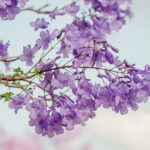Are you ready to dive into the captivating world of indigo? In this article, we will embark on a journey uncovering the enigmatic history and fascinating facts surrounding this mystical plant. From its ancient origins to its profound cultural significance, indigo has mesmerized humanity for centuries. So, fasten your seatbelts and prepare to be enthralled as we unravel the secrets of indigo’s past and explore its rich tapestry of uses and properties. Get ready to immerse yourself in the world of indigo, a hue that has captured the imagination of countless cultures throughout history.

Facts About Indigo
Indigo, a captivating shade of blue that evokes a sense of mystery and allure, holds a rich history and intriguing set of properties. Delving into the enigmatic world of indigo, we uncover a multitude of fascinating facts that shed light on its significance in different cultures, its role in art and fashion, and its medicinal uses.
The Origins of Indigo
- Let’s begin with the origin of the name itself – indigo. Derived from the Greek word “indikon,” meaning “from India,” the name refers to the indigo plant, Indigofera tinctoria, which was historically cultivated for its deep blue dye.
- Stretching back centuries, indigo holds the distinction of being one of the oldest dyes in the world. From ancient civilizations to the vibrant cultures of Asia and Africa, indigo has played a vital role in dyeing textiles, decorating art, and even traditional medicine. It’s a hue steeped in history and cultural significance.
Indigo in Art and Fashion
- Indigo’s allure extends beyond its historical uses. In the realm of art, indigo has been a sought-after pigment for centuries. Renowned physicist and mathematician Sir Isaac Newton named and defined indigo as a distinct color in his division of the rainbow spectrum, highlighting its significance in the world of colors.
- Pioneer in the world of fashion, indigo dye has left an indelible mark. It has been prominently used in denim production, giving birth to the iconic “blue jeans” we know today. Indigo dye, with its deeply saturated hue, adds character and depth to denim, ensuring its enduring popularity across generations.
Indigo’s Place in Traditional Medicine
- Beyond its role in art and fashion, indigo has been used in traditional medicine across diverse cultures. In Ayurveda, the ancient Indian system of medicine, indigo has been harnessed for its numerous health benefits. It has been used for detoxification, liver cleansing, and supporting overall well-being.
- “Indigo’s distinctive properties have not only fueled its creative applications but also made it a valued ingredient in traditional healing practices.”
The Indigo Plant and the Mass Production Rush
- Let’s take a closer look at the indigo plant itself. Indigofera tinctoria, a tropical herb or small bushy perennial shrub, is one of the primary species historically used to obtain indigo dye. Another species, Indigofera suffruticosa, has also been utilized for this purpose.
- The popularity of indigo and its dyeing properties led to a rush among European countries to mass-produce it in the 17th and 18th centuries. This demand for indigo, often referred to as “blue gold,” transformed the global textile industry, shaping patterns of trade and colonization.
The Enigmatic Power of Indigo
- Delving further into the allure of indigo, we find that this captivating hue has also been associated with various symbolic and spiritual meanings. It has been tied to concepts of intuition, wisdom, and spirituality in different cultures. Indigo’s mysterious and profound nature has elicited a sense of wonder and intrigue throughout history.
- Indigo’s wide-ranging applications, from ancient rituals to modern-day fashion, testify to its enduring appeal and versatility. Its ability to evoke emotions and act as a visual storyteller makes it an essential color in the artistic and cultural landscape.
As we peel back the layers of indigo, we uncover a kaleidoscope of historical, artistic, and medicinal significance. From its role in ancient civilizations to its presence in our modern-day lives, indigo’s mesmerizing qualities enhance the world around us. As you embrace the enchanting world of indigo, let its deep hues inspire you and open doors to exploration and curiosity.
“Indigo, a color that unveils the hidden depths of history, invites us to embark on a journey where art, fashion, and healings seamlessly intertwine.”
Facts About Indigo
Indigo, a fascinating and vibrant color, has been used for centuries in various ways. Have you ever wondered what indigo is used for? Allow me to take you on a journey and discover the numerous applications of this captivating color. From dyeing fabrics to creating beautiful artworks, indigo possesses an undeniable charm that has captivated artists and artisans alike. If you’re curious about the indigo plant and its significance, let me share some interesting facts about indigo plants that will surely pique your interest. Click here to discover more: What Is Indigo Used For.
But that’s not all! Indigo plants hold a rich history and cultural significance. Curious to know where indigo grows abundantly? Join me on an exploration of the regions where this majestic plant thrives. Experience the indigo plant’s natural habitat and how its cultivation has impacted various communities. For an insightful journey into the origins of indigo, click here: Where Does Indigo Grow.
Did you know that indigo dye has been used for centuries to create stunning textiles? Indigo dye has a unique charm that adds depth and character to fabrics. Delve into the world of indigo dye and learn amazing facts about its production process and how it has influenced textile traditions worldwide. Discover fascinating information about indigo dye here: Facts About Indigo Dye.
Now, let’s delve deeper into the indigo plant itself. Journey into the heart of indigo cultivation and uncover intriguing facts about this extraordinary plant. From its medicinal properties to its role in cultural practices, the indigo plant is a true marvel. Click here to explore the wonders of the indigo plant: Indigo Plant.
Lastly, let’s explore the art of indigo dyeing. Discover the secrets behind this ancient technique and the significance it holds in different cultures around the world. Whether you’re an artist or simply an admirer of beautiful crafts, understanding indigo dye will surely enrich your appreciation for this timeless art form. Learn more about the art of indigo dyeing here: What Is Indigo Dye.
Indigo is a color that has stood the test of time, captivating individuals across cultures and generations. Explore the fascinating world of indigo – its uses, its history, and its beauty – and embark on a journey that will leave you mesmerized.
Facts About the Indigo Plant
Indigo is a captivating hue that has captivated cultures and artists for centuries. Let’s delve into some fascinating facts about the indigo plant and uncover the secrets behind this enigmatic color.
A Colorful Family
Indigo plants belong to the Fabaceae or legume family, renowned for their ability to fix nitrogen in the soil. These plants are native to tropical and subtropical regions across the globe, showcasing their adaptability to various environments. With their silky or hairy appearance and compound leaves, indigo plants exhibit a captivating range of shapes and sizes.
“Indigo plants, with their diverse appearances, truly exemplify the beauty of nature’s creativity.”
Healing Powers in Roots
Native American Indians cherished the indigo plant for its medicinal properties. They used a decoction of the roots as an antiseptic wash for wounds and skin complaints. Modern research has shown that the bitter herb boosts the immune system and effectively combats bacterial infections.
“The indigo plant not only paints nature with its magnificent blue hues but also supports healing with its medicinal properties.”
Powerful Teas
Indigo plants offer a range of health benefits when transformed into teas. The roots of the plant hold cholagogue, emetic, febrifuge, and purgative properties. These teas can aid in digestive health, detoxification, and fever reduction.
“Sipping on an indigo tea can be a soothing and invigorating way to tap into the natural goodness of these charming plants.”
The Secret of True Indigo
One of the most well-known species of indigo plant is Indigofera tinctoria, which has been used for centuries to produce the coveted indigo dye. The leaves of this particular plant are turned into powder, boiled down, and fermented until they yield the distinctive deep blue color that indigo has become known for.
“The indigo plant holds its secrets within its leaves, creating a dye that mesmerizes and captivates with its timeless beauty.”
History
Indigo, with its captivating blue hue, has a rich and fascinating history that spans across continents and centuries. The indigo dye has been used by various ancient civilizations, simultaneously in countries like China, India, Africa, and South America. Its roots can be traced back to around 4000 BC in Peru, making it one of the oldest dyes known to mankind.
[Quote: “From the ancient civilizations of Peru to the bustling markets of India, indigo has left an indelible mark on human history.”]
Pliny the Elder, a renowned Roman author and naturalist, mentioned India as the source of this remarkable dye, which is how it obtained its name. But it’s worth noting that indigo cultivation actually originated in the Indus Valley more than 5,000 years ago. The word “indigo” itself is derived from the Greek word meaning “from India.” This highlights the significance of India’s contribution to the indigo trade and its cultural influence.
[Quote: “Indigo’s journey across civilizations and cultures makes it a fascinating color with a truly global heritage.”]
Indigo cultivation and use as a dye spread throughout various regions, including East Asia, Egypt, India, Bangladesh, and Peru. In Asia, countries like India, China, Japan, and Southeast Asian nations have been using indigo as a dye for centuries, especially for silk. The history of indigo in these cultures is intertwined with traditional art forms, textile production, and rituals.
[Quote: “The brilliant blue of indigo has graced the silks of empresses, the garments of warriors, and the sacred tapestries of ancient temples.”]
In fact, the oldest fabric dyed with indigo, dating back an astonishing 6,000 years, was discovered in Peru. This finding highlights the significance of indigo in ancient South American cultures and their mastery of textile dyeing techniques. Throughout history, indigo has been traded across Asia, Africa, and Europe, becoming a symbol of wealth, power, and prestige.
[Quote: “Indigo’s allure as a prized commodity transcended borders and connected civilizations.”]
However, the history of indigo is not without its dark side. During the era of colonialism, indigo played a significant role in the exploitation of farmers. In countries like India, farmers were forced to grow indigo and faced oppression and harsh working conditions. This led to movements and rebellions against indigo plantations, such as the Indigo Revolt, which fought for freedom and fair treatment.
[Quote: “Indigo’s history is not just one of beauty and cultural exchange, but also a reminder of the struggles and injustices faced by those who depended on it.”]
Today, indigo continues to be a beloved color with a prominent presence in various industries, including fashion and decor. Its deep and mysterious hue adds a touch of elegance and sophistication to garments, walls, and decor elements. The production and use of indigo have had a lasting impact on culture and history worldwide, making it a color that stands the test of time.
[Quote: “Indigo remains a timeless and cherished color, weaving together the threads of history, art, and culture.”]
The Facts About IndiGo Airlines That Will Astonish You
[youtube v=”0PksGT_fpmA”]
IndiGo Airlines: India’s Leading Low-Cost Carrier
IndiGo Airlines is a prominent Indian low-cost airline that has rapidly grown to become one of the largest airline companies worldwide. Headquartered in Gurgaon, Haryana, it boasts an impressive fleet size of 281 aircraft, including A320 Neo, A320 CEO, ATRs, and A321 Neo models. With an unparalleled market share, IndiGo Airlines has emerged as the sole profitable airline in India.
“IndiGo Airlines is the only profitable airline company in India, cementing its position as a leader in the aviation industry.”
A Remarkable Feat: Skytrax Best Low-Cost Airline
This year, IndiGo Airlines accomplished a remarkable milestone by receiving the prestigious Skytrax award for the best low-cost airline for the eighth consecutive year. This recognition reflects IndiGo’s commitment to providing exceptional service and value to its passengers, solidifying its reputation as Asia’s third-largest and one of the world’s top ten airlines.
“IndiGo Airlines’ consistent recognition as the best low-cost airline demonstrates its unwavering dedication to customer satisfaction and excellence.”
Innovative Services: Door-to-Door Baggage and Record-Breaking Cargo
IndiGo Airlines has pioneered several innovative services to enhance the travel experience for its passengers. As India’s first airline to introduce door-to-door baggage service, IndiGo’s 6Ebag port, in partnership with Carter Porter, offers unparalleled convenience and efficiency. Additionally, IndiGo’s cargo team achieved a remarkable milestone by uplifting a staggering 20,212 kilograms on its Cochin to Avid Habib freighter flight, setting a new record.
“IndiGo Airlines continues to innovate and set industry standards with its groundbreaking services such as door-to-door baggage and record-breaking cargo operations.”
A Dream Career: Joining the IndiGo Team
For aviation enthusiasts aspiring to work in the industry, IndiGo Airlines is an ideal choice. Joining the IndiGo team offers exciting opportunities to contribute to the success of this renowned airline. Aspiring aviation professionals should consider familiarizing themselves with these essential facts about IndiGo Airlines.
“For those passionate about aviation, a career with IndiGo Airlines opens the door to exciting opportunities within the industry.”
Final Thoughts
IndiGo Airlines has etched its name in the aviation industry by emerging as India’s leading low-cost carrier. With its impressive fleet, consistent profitability, and numerous accolades, IndiGo’s commitment to excellence is evident. Whether it’s pioneering innovative services or providing exceptional travel experiences, IndiGo continues to redefine air travel in India and beyond.
“IndiGo Airlines’ relentless commitment to excellence has positioned it as a trailblazer and leader in the aviation industry.”
FAQ
What is indigo?
Indigo is a shade of blue, specifically purplish blue or dark blue. Isaac Newton named and defined indigo as a spectrum color when he divided up the spectrum into the seven colors of the rainbow.
Where does the name “indigo” come from?
The name of the color indigo originally came from the indigo plant. The word “indigo” is derived from Greek and means “from India.”
How long has indigo been used as a dye?
Indigo is one of the oldest dyes in the world and was used in ancient China, India, Africa, and South America simultaneously. The earliest direct evidence of the use of indigo dates back to around 4000 BC in Peru.
What are some traditional uses of indigo?
Indigo has been used in traditional medicine for various purposes. It has Ayurvedic health benefits and has been used medically, including for liver cleansing and blood detoxification.
What impact did indigo have on history?
The production and use of indigo have had a lasting impact on culture and history worldwide. Indigo played a significant role in colonialism, sparking rebellions and revolutions such as the Indigo Revolt. It remains a popular color today and is used in various industries, including fashion and decor.
















